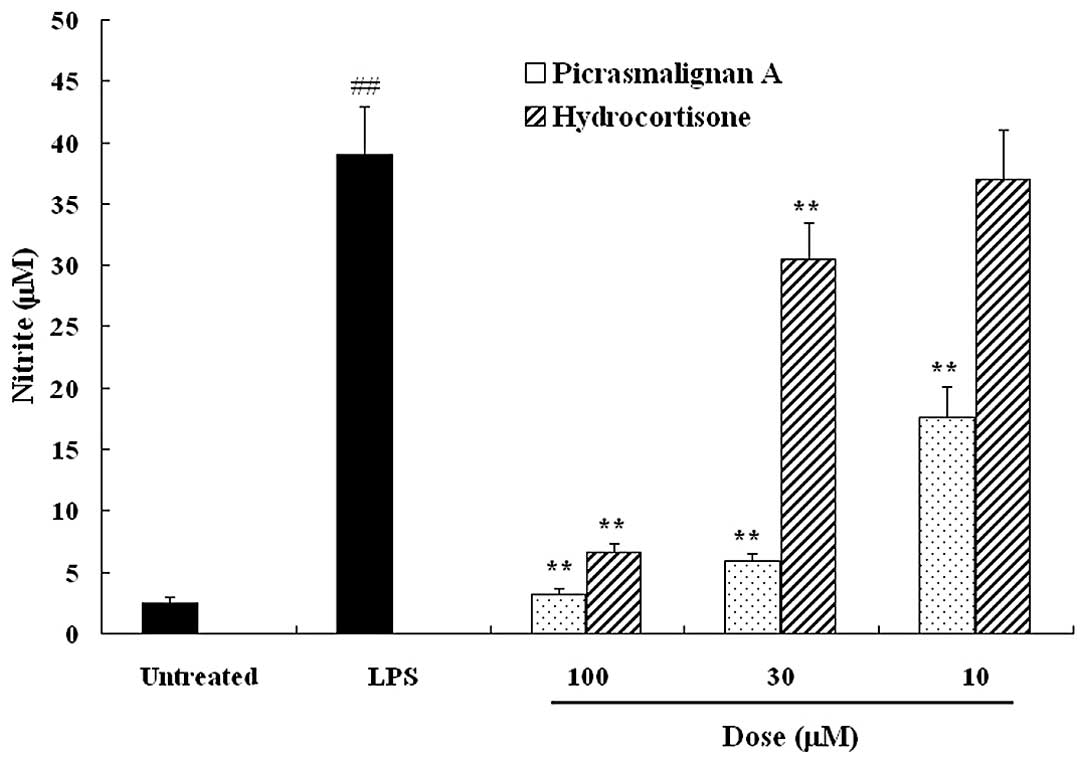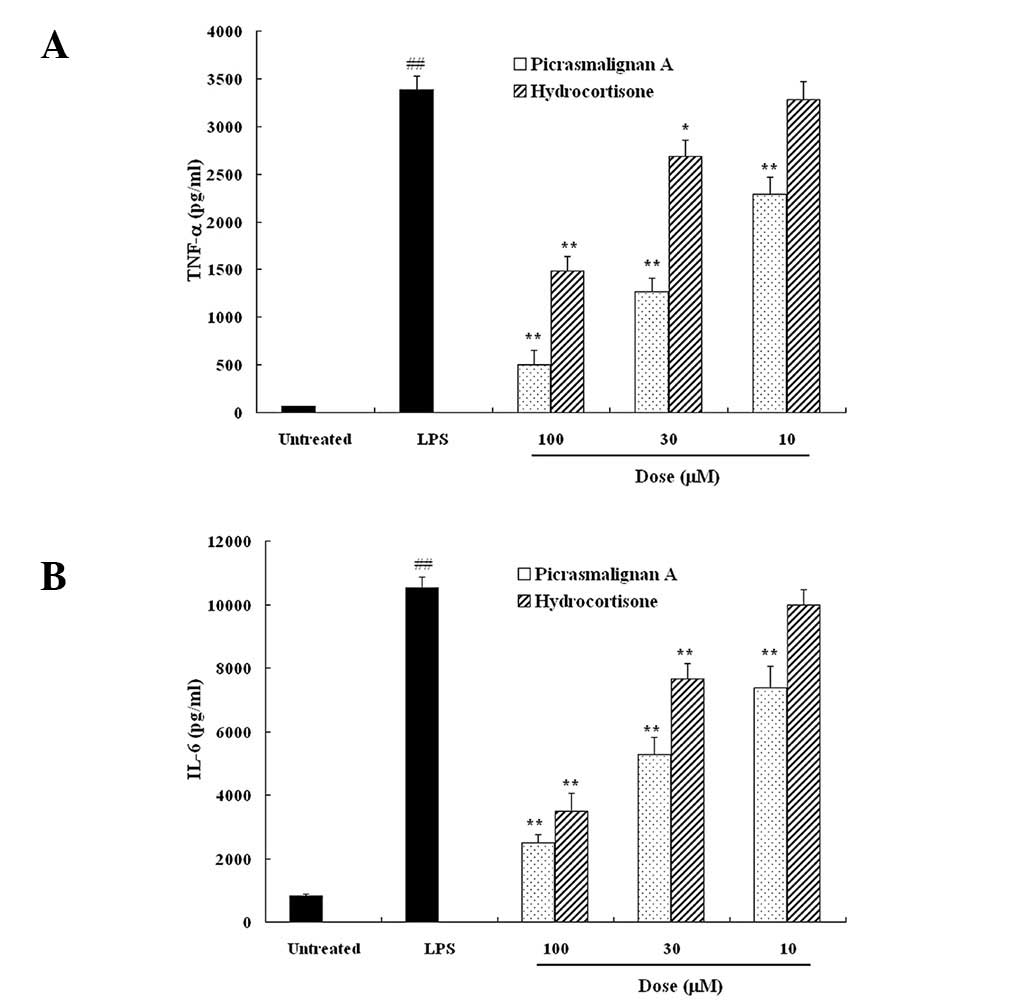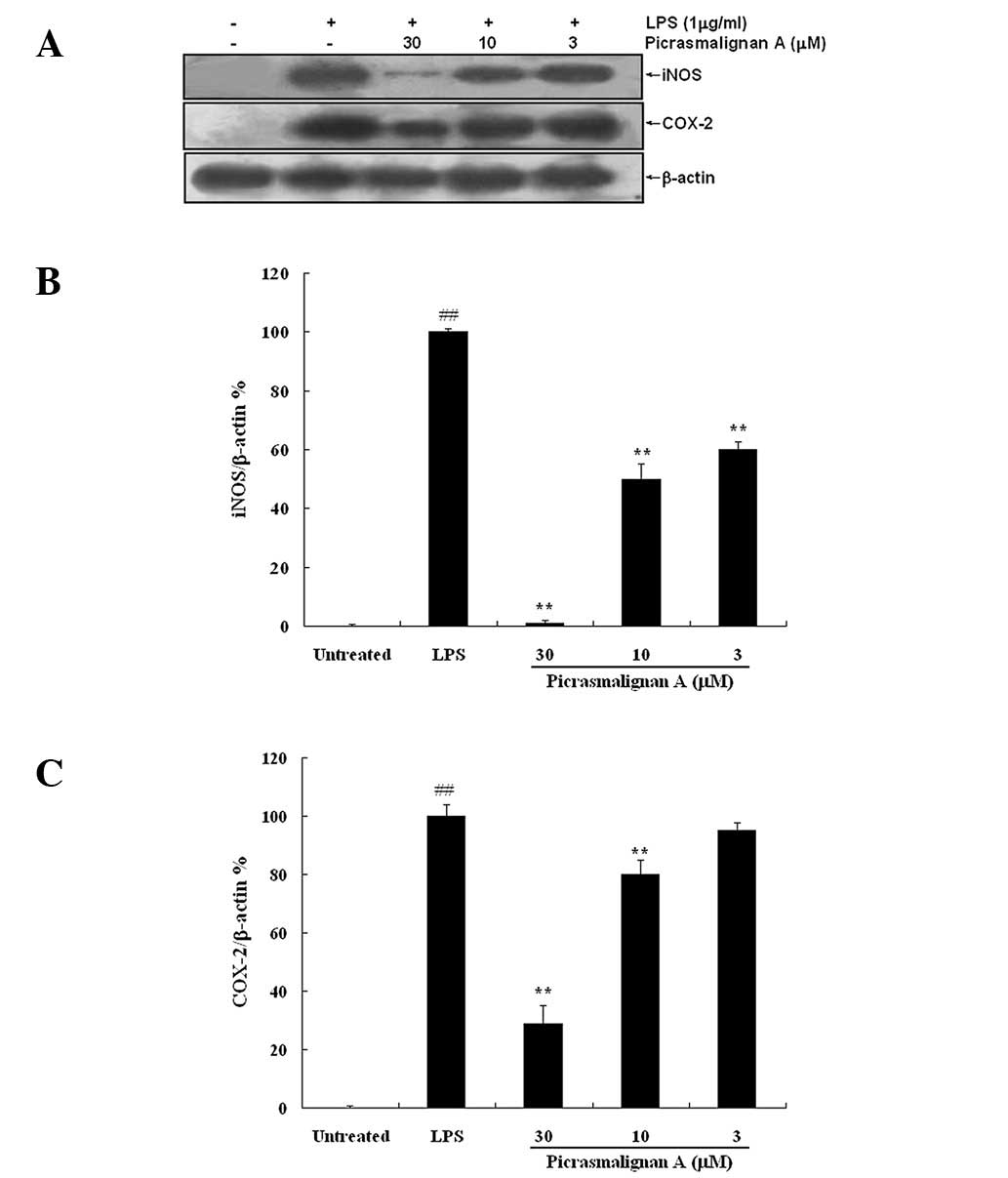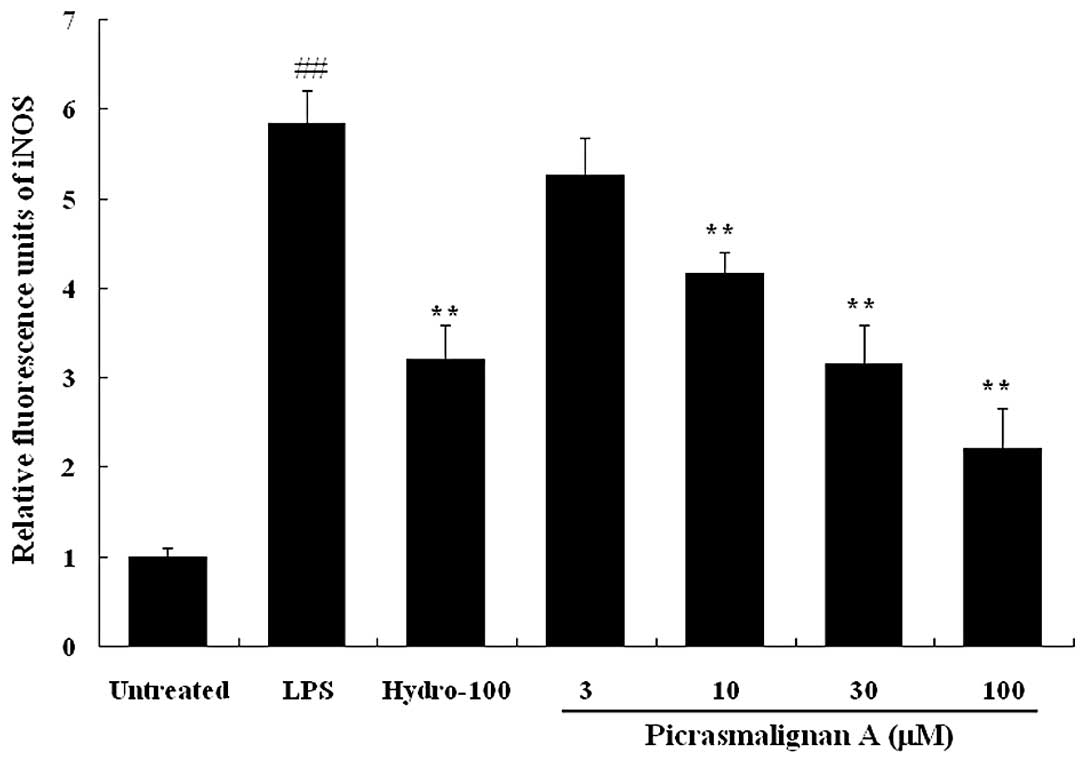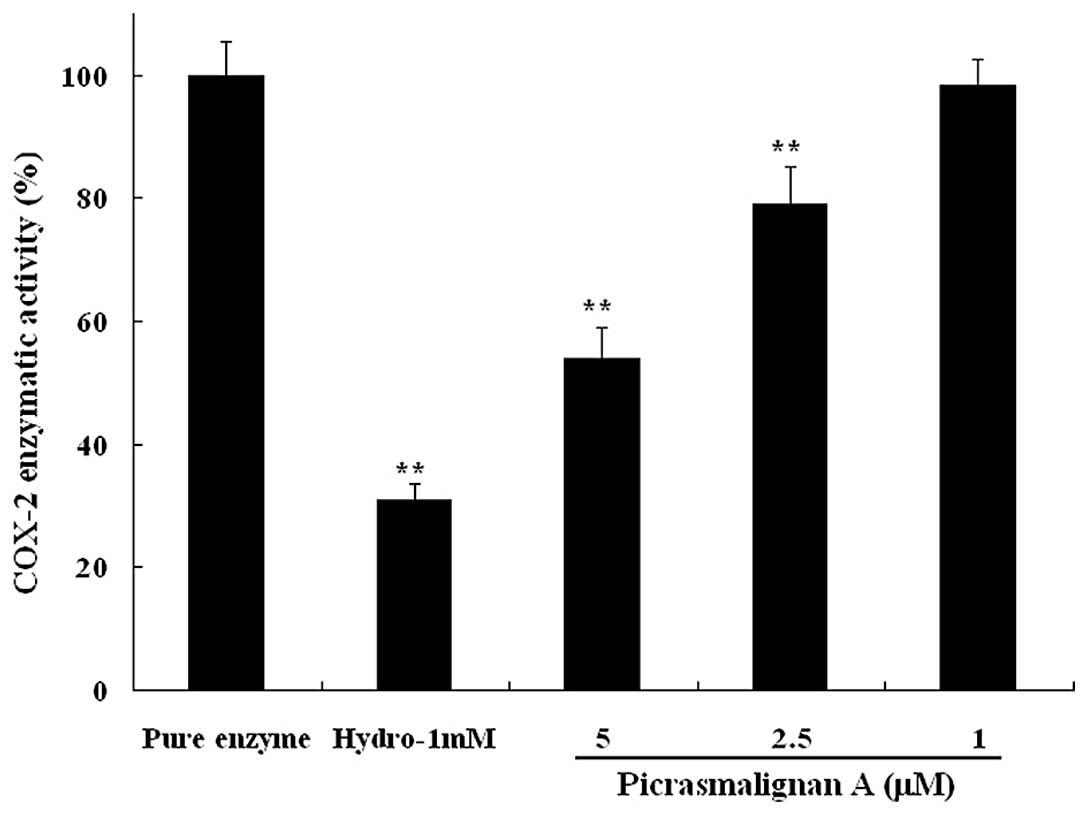In vitro anti-inflammatory effect of picrasmalignan A by the inhibition of iNOS and COX‑2 expression in LPS‑activated macrophage RAW 264.7 cells
- Authors:
- Published online on: August 30, 2013 https://doi.org/10.3892/mmr.2013.1663
- Pages: 1575-1579
Abstract
Introduction
Picrasma quassioides Benn. (of the Simaroubaceae family) is a traditional Chinese medicinal plant predominantly found in Southern China. The stems have been used for the treatment of inflammation, gastroenteritis, eczema and snakebites. However, the active constituents of this plant and their mechanisms of action in treating these diseases remain to be elucidated. Previous chemical investigation of this plant has led to the isolation of several alkaloids and quassinoids (aglycones), such as β-carbolines, canthin-6-ones and bis-β-carbolines (1–3). Studies aiming to elucidate the active constituents of P. quassioides have isolated and identified 48 compounds, including 25 β-carboline alkaloids, six canthinone alkaloids, 11 bis-β-carboline alkaloids, three lignins, two quassinoids and a flavonol (4–7). In the present study, the anti-inflammatory effects and molecular mechanisms of the neolignan, picrasmalignan A, were investigated.
Following inflammatory stimulation, macrophages produce nitric oxide (NO) and proinflammatory cytokines, such as tumor necrosis factor (TNF)-α and interleukin (IL)-6. These mediators are highly expressed in macrophages in numerous inflammatory diseases, including rheumatoid arthritis, atherosclerosis and hepatitis (8–10). NO, an important cellular second messenger, is produced via three types of nitric oxide synthase (NOS). Small quantities of NO produced by the constitutive NOS are essential for maintaining normal cellular function. Inducible NOS (iNOS) sustainably produces a high output of NO, which is one of the most important inflammatory reactions in activated macrophages (11).
In addition, two isoforms of cyclooxygenase, COX-1 and COX-2, which are encoded by separate genes, have been identified (12). The COX-1 isozyme is expressed at a constant level and does not fluctuate in response to various stimuli. By contrast, COX-2 is induced by lipopolysaccharide (LPS) and is the target enzyme for the anti-inflammatory activity of nonsteroidal anti-inflammatory drugs. Numerous studies have demonstrated that certain inducible enzymes (COX and iNOS), cytokines and their reaction products are involved in chronic inflammatory diseases (13–15).
Thus, the effect of picrasmalignan A on LPS-stimulated proinflammatory mediators (including NO, TNF-α and IL-6) in macrophages, and on the expression of iNOS and COX-2, was also investigated. In addition, the inhibitory effect of picrasmalignan A on iNOS and COX-2 enzymatic activity in LPS-stimulated RAW 264.7 cells was demonstrated.
Materials and methods
Isolation and identification of picrasmalignan A
Picrasmalignan A was isolated and identified as previously demonstrated (4). Briefly, the stems of P. quassioides (100 kg) were extracted with 95% EtOH and the compounds were isolated from the ethanolic extract. The dried ethanolic extract (200 g) was suspended in water and partitioned with CHCl3, AcOEt and BuOH to yield CHCl3-soluble (128 g), AcOEt-soluble (8.12 g) and BuOH (20.8 g) fractions. The CHCl3-soluble fraction was subjected to silica gel column chromatography eluted with cyclohexane, cyclohexane/AcOEt, AcOEt and MeOH to produce 10 fractions. Fraction 7 (19.2 g) was eluted with cyclohexane/AcOEt 5:5 and then purified by silica gel column chromatography (CHCl3/MeOH gradient) to yield seven subfractions. The fourth subfraction was purified by silica gel column chromatography and high-performance liquid chromatography (HPLC) to yield picrasmalignan A (2.9 mg). Its chemical structure (Fig. 1) was identified by the chemical and physical properties, and spectra data.
Picrasmalignan A: white powder, [α] −13.2° (c0.5, MeOH); UV (MeOH) λmax (log ɛ) 208 (3.95), 283 (3.08), 337 (3.15) nm; IR (KBr) νmax 3404, 2942, 1661, 1597, 1497, 1482, 1383, 1330, 1278, 1213, 1138, 1031, 825 cm−1; 1H NMR (400 MHz, DMSO-d6) and 13C NMR (100 MHz, DMSO-d6), listed in Table I; ESIMS (positive) m/z 557 [M+Na]+, ESIMS (negative) m/z 569 [M+Cl]−; HRESIMS m/z 535.1941 [M+H]+ (calculated for C30H31O9, 535.1963).
Reagents
RPMI-1640 medium and fetal bovine serum were purchased from Invitrogen Life Technologies (Carlsbad, CA, USA). LPS, dimethylsulfoxide (DMSO), MTT and DAF-FM DA were obtained from Sigma-Aldrich (St. Louis, MO, USA). Nicotinamide adenine dinucleotide phosphate (NADPH) was purchased from Wako Pure Chemical Industries, Ltd. (Tokyo, Japan). The penicillin-streptomycin stock solution, mouse TNF-α ELISA, mouse IL-6 ELISA, Bradford protein assay and nitric oxide synthase assay kits were obtained from Yantai Science and Biotechnology Co., Ltd. (Yantai, China). The colorimetric COX (ovine) inhibitor screening assay kit, anti-murine iNOS polyclonal antibody and COX-2 (murine) polyclonal antibody were obtained from Cayman Chemical (Ann Arbor, MI, USA). β-actin antibody was purchased from Santa Cruz Biotechnology, Inc. (Santa Cruz, CA, USA). Hydrocortisone (H4001; purity HPLC ≥98%; Sigma-Aldrich) was used as a positive control in all experiments.
Cell culture
Mouse monocyte-macrophage RAW 264.7 cells (ATCC TIB-71; American Type Culture Collection, Manassas, VA, USA) were maintained in RPMI-1640 medium supplemented with 10% heat-inactivated FBS at 37°C in a humidified incubator with 5% CO2 and 95% air. The medium was replaced every 2 days. RAW 264.7 cells were passaged by trypsinization until 80% confluence was achieved.
Cell viability assay
RAW 264.7 cells were treated with picrasmalignan A at concentrations of 1–100 μM. The mitochondrial-dependent reduction of MTT to formazan was used to measure cell respiration as an indicator of cell viability. Briefly, following 24 h incubation, an MTT solution (final concentration, 200 μg/ml) was added and the cells were incubated for another 4 h at 37°C. Following the removal of the supernatant, 100 μl DMSO was added to the cells to dissolve the formazan. The absorbance of each group was measured by a microplate reader at a wavelength of 570 nm (Biotek Synergy HT; BioTek Instruments, Inc., Winooski, VT, USA). The control group consisted of untreated cells, which were considered to be 100% viable. Results are expressed as the percentage of viable cells when compared with that of the control group.
NO analysis
NO levels were determined by measuring the quantity of nitrite in the cell culture supernatant using Griess reagent. RAW 264.7 cells were treated with LPS (1 μg/ml) with or without picrasmalignan A (10–100 μM) for 24 h. Cell culture supernatant (100 μl) was mixed with 100 μl Griess reagent and absorbance was measured at 540 nm. The nitrite concentrations were calculated using a standard calibration curve prepared from different concentrations of sodium nitrite.
Measurement of TNF-α and IL-6
RAW 264.7 cells were treated with LPS (1 μg/ml) with or without picrasmalignan A (10–100 μM) for 6 h. The culture supernatant (100 μl) was removed to determine the level of TNF-α and IL-6 using the respective mouse TNF-α and mouse IL-6 ELISA kits, according to the manufacturer’s instructions.
Detection of iNOS, COX-2 and β-actin expression
RAW 264.7 cells were washed with cold phosphate-buffered saline (PBS) and lysed in western cell lysis buffer 24 h following treatment. Cell debris was removed by centrifugation. Following the determination of the protein concentration of each aliquot by a commercial Bradford protein assay kit, 30 μg total protein boiled in sodium dodecyl sulfate-polyacrylamide gel electrophoresis loading buffer was subjected to gel electrophoresis and electrophoretically transferred onto nitrocellulose membranes. The membranes were blocked with 5% non-fat dried milk in Tris-buffered saline with Tween 20 (TBST) at room temperature for 1 h. Following washing, the membranes were incubated in the respective primary antibody solution (anti-iNOS, anti-COX-2 and anti-β-actin antibodies) overnight at 4°C. The membranes were washed with TBST and incubated with horseradish peroxidase-conjugated secondary antibody solution for 1 h at room temperature. The blots were washed again three times in TBST, detected using enhanced chemiluminescence (ECL) and exposed to photographic films. Images were collected and the bands corresponding to iNOS, COX-2 and β-actin were quantitated by densitometric analysis using DigDoc100 program (Genetic Technologies, Inc., Glencoe, MO, USA). Data regarding iNOS and COX-2 were normalized on the basis of the β-actin levels.
Assay of iNOS enzymatic activity
RAW 264.7 cells were treated with LPS (1 μg/ml) and picrasmalignan A (3–100 μM) for 2 h at 3°C, the culture supernatant was removed and 100 μl NOS assay buffer were added to each well. Then 100 μl NOS assay reaction solution (50% NOS assay buffer, 39.8% MilliQ water, 5% L-Arginine solution, 5% 0.1 mM NADPH, 0.2% DAF-FM DA) was added to each well and incubated for 2 h at 37°C. Fluorescence was measured with a fluorescence plate reader (Biotek Synergy HT; BioTek Instruments, Inc.) at excitation 485 nm and emission 528 nm.
Assay of COX-2 enzymatic activity
COX-2 activity was determined by a colorimetric COX inhibitor screening assay kit according to the manufacturer’s instructions. Briefly, 160 μl assay buffer and 10 μl heme were added to the background wells, while 150 μl assay buffer, 10 μl heme and 10 μl COX-2 enzyme were added to the 100% initial activity wells. Picrasmalignan A (10 ml; final concentrations, 1, 2.5 and 5 mM) was added to the sample wells and 10 μl DMSO was added to the background wells. The plate was carefully shaken for a few seconds and incubated for five min at 25°C. The colorimetric substrate solution (20 μl) followed by arachidonic acid (20 μl) were added to each well. The plate was again shaken carefully for a few seconds and incubated for 5 min at 25°C. The absorbance at 590 nm was read by a microplate reader and the inhibition ratio of COX-2 enzymatic activity was calculated according to the manufacturer’s instructions.
Statistical analysis
All results are presented as the mean ± standard deviation. Statistical comparison was conducted using Student’s t-test following analysis of variance (ANOVA). P<0.05 was considered to indicate a statistically significant difference.
Results
RAW 264.7 cells were treated with various concentrations of picrasmalignan A for 24 h and the cell viability was tested by an MTT assay as described in Materials and methods. Picrasmalignan A did not demonstrate cytotoxicity in the range of 1–100 μM (data not shown). RAW 264.7 cells were then treated with 1 μg/ml LPS with or without the indicated concentrations of picrasmalignan A or hydrocortisone. After 24 h, nitrite concentrations were determined as an indicator of the NO production. As shown in Fig. 2, picrasmalignan A significantly inhibited the LPS-induced production of NO to an even greater extent than the positive control hydrocortisone, a commonly used anti-inflammatory drug. RAW 264.7 cells were treated with 1 μg/ml LPS with or without the indicated concentrations of picrasmalignan A or hydrocortisone for 6 h, and the resulting pro-inflammatory cytokine levels of TNF-α and IL-6 in the supernatant were determined by an ELISA assay. As shown in Fig. 3, LPS-induced TNF-α and IL-6 release were significantly suppressed by picrasmalignan A in a dose-dependent manner. Furthermore, the inhibitive action of picrasmalignan A was more potent than that of the positive control, hydrocortisone. These results demonstrated that picrasmalignan A significantly inhibited the expression of LPS-induced proinflammatory mediators, such as NO, TNF-α and IL-6, in macrophages, which may be responsible for its anti-inflammatory effect.
As the excess production of NO is correlated with the upregulation of inducible nitric oxide synthase (iNOS) expression, the expression of iNOS and COX-2 was investigated by western blot analysis. As shown in Fig. 4A, treatment with 30 μM picrasmalignan A almost completely inhibited the expression of iNOS and significantly inhibited the LPS-induced overexpression of COX-2. The density of bands corresponding to the iNOS and COX-2 proteins were normalized on the basis of β-actin and are shown in Fig. 4B and 4C, respectively.
The inhibitory effects of picrasmalignan A on the activity of the iNOS and COX-2 enzymes were determined. As shown in Fig. 5, treatment with 1 μg/ml LPS led to an ~6-fold increase of iNOS enzymatic activity within 2 h. The indicated concentrations of picrasmalignan A (3, 10, 30 and 100 μM) markedly inhibited the iNOS enzymatic activation in RAW 264.7 cells and demonstrated dose-dependency. Picrasmalignan A (2.5 and 5 mM) also significantly inhibited the activity of the COX-2 enzyme, similarly to that of the positive control, hydrocortisone (Fig. 6).
Discussion
P. quassioides is a commonly used traditional Chinese medicine predominantly used to treat fever and inflammation.. It has previously been demonstrated that β-carboline alkaloids (the predominant active constituents of this medicinal plant) exert anti-inflammatory effects through the inhibition of the iNOS pathway but independent of the COX-2 pathway (16). In the present study, another type of natural compound neolignan, picrasmalignan A, was further examined for its possible anti-inflammatory molecular mechanism. The results demonstrated that picrasmalignan A blocked various LPS-induced macrophage responses including the increased production of inflammatory mediators (NO, TNF-α, IL-6), the overexpression of iNOS and COX-2, and the activity of iNOS and COX-2 enzymes. To the best of our knowledge, this is the first study to demonstrate the anti-inflammatory effect of neolignan agents. These results also suggested that neolignan and β-carboline alkaloids coexist in P. quassioides and may exert the anti-inflammatory effect through different pathways.
Acknowledgements
This study was supported by the Project of National Natural Science Foundation of China (grant no. 81102781) and the Taishan Scholar Project to Fenghua Fu.
References
|
Ohmoto T and Koike K: Studies on the constituents of Picrasma quassioides Bennet I. On the alkaloidal constituents. Chem Pharm Bull. 30:1204–1209. 1982. | |
|
Ohmoto T and Koike K: Studies on the constituents of Picrasma quassioides Bennet II. On the alkaloidal constituents. Chem Pharm Bull. 31:3198–3204. 1983. | |
|
Ohmoto T and Koike K: Studies on the constituents of Picrasma quassioides Bennet III. The alkaloidal constituents. Chem Pharm Bull. 32:3579–3583. 1984. | |
|
Jiao WH, Gao H, Zhao F, He F, Zhou GX and Yao XS: A new neolignan and a new sesterterpenoid from the stems of Picrasma quassioides Bennet. Chem Biodivers. 8:1163–1169. 2011. View Article : Google Scholar : PubMed/NCBI | |
|
Jiao WH, Gao H, Zhao F, Lin HW, Pan YM, Zhou GX and Yao XS: Anti-inflammatory alkaloids from the stems of Picrasma quassioides Bennet. Chem Pharm Bull (Tokyo). 59:359–364. 2011. View Article : Google Scholar : PubMed/NCBI | |
|
Jiao WH, Gao H, Li CY, Zhao F, Jiang RW, Wang Y, Zhou GX and Yao XS: Quassidines A–D, bis-beta-carboline alkaloids from the stems of Picrasma quassioides. J Nat Prod. 73:167–171. 2010. | |
|
Jiao WH, Gao H, Li CY, Zhou GX, Kitanaka S, Ohmura A and Yao XS: Beta-carboline alkaloids from the stems of Picrasma quassioides. Magn Reson Chem. 48:490–495. 2010.PubMed/NCBI | |
|
Tilg H, Wilmer A, Vogel W, Herold M, Nölchen B, Judmaier G and Huber C: Serum levels of cytokines in chronic liver diseases. Gastroenterology. 103:264–274. 1992.PubMed/NCBI | |
|
Libby P, Ridker PM and Maseri A: Inflammation and atherosclerosis. Circulation. 105:1135–1143. 2002. View Article : Google Scholar : PubMed/NCBI | |
|
Isomäki P and Punnonen J: Pro- and anti-inflammatory cytokines in rheumatoid arthritis. Ann Med. 29:499–507. 1997. | |
|
Pokharel YR, Liu QH, Oh JW, Woo ER and Kang KW: 4-Hydroxykobusin inhibits the induction of nitric oxide synthase by inhibiting NF-kappaB and AP-1 activation. Biol Pharm Bull. 30:1097–1101. 2007. View Article : Google Scholar : PubMed/NCBI | |
|
Emery P: COX-1, COX-2: so what? Scand J Rheumatol. 28:6–9. 1999. View Article : Google Scholar : PubMed/NCBI | |
|
Abd-El-Aleem SA, Ferguson MW, Appleton I, Bhowmick A, McCollum CN and Ireland GW: Expression of cyclooxygenase isoforms in normal human skin and chronic venous ulcers. J Pathol. 195:616–623. 2001. View Article : Google Scholar : PubMed/NCBI | |
|
Bruch-Gerharz D, Stahl W, Gerharz CD, Megahed M, Wingerath T, Sies H and Ruzicka T: Accumulation of the xanthophyll lutein in skin amyloid deposits of systemic amyloidosis (al type). J Invest Dermatol. 116:196–197. 2001. View Article : Google Scholar : PubMed/NCBI | |
|
Bruch-Gerharz D, Fehsel K, Suschek C, Michel G, Ruzicka T and Kolba-Bachofen V: A proinflammatory activity of interleukin 8 in human skin: expression of the inducible nitric oxide synthase in psoriatic lesions and cultured keratinocytes. J Exp Med. 184:2007–2012. 1996. View Article : Google Scholar : PubMed/NCBI | |
|
Zhao F, Gao Z, Jiao W, Chen L, Chen L and Yao X: In vitro anti-inflammatory effects of beta-carboline alkaloids, isolated from Picrasma quassioides, through inhibition of the iNOS pathway. Planta Med. 78:1906–1911. 2012. View Article : Google Scholar : PubMed/NCBI |




